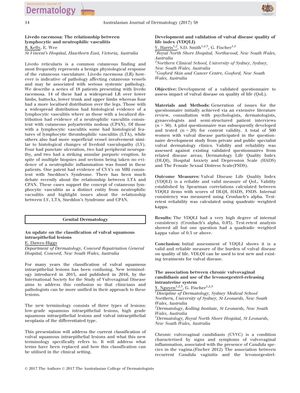Genital Dermatology
April 2017
in “
Australasian Journal of Dermatology
”

TLDR Different skin conditions show distinct types of vessel inflammation, a new quality of life index for vulval disease is reliable, a certain intrauterine system might be linked to chronic vaginal yeast infections, and oral minoxidil reduces hair loss in women.
The document presents several studies and updates in the field of dermatology, with a focus on genital dermatology and hair loss conditions.
One study described a series of 18 patients with livedo racemosa (LR), a skin condition indicating pathology in cutaneous vessels. It found that widespread LR was associated with lymphocytic vasculitis, while localized LR was linked to neutrophilic vasculitis, consistent with cutaneous polyarteritis nodosa (CPAN). This supports the concept of cutaneous lymphocytic vasculitis as distinct from neutrophilic vasculitis and raises questions about the relationship between various related syndromes.
Another study developed and validated the Vulval Disease Quality of Life Index (VDQLI) using a sample of 300 women with vulval disease. The VDQLI showed high internal consistency (Cronbach's alpha of 0.93) and good test-retest reliability, indicating it is a valid and reliable measure of the burden of vulval disease on quality of life.
A case series of 13 patients explored the association between chronic vulvovaginal candidiasis (CVVC) and the use of the levonorgestrel-releasing intrauterine system. All patients treated with oral fluconazole showed a clinical response at 12 weeks, suggesting a potential link between the intrauterine system and CVVC.
Lastly, a study on chronic telogen effluvium (CTE), a hair loss condition, treated 36 women with oral minoxidil. Results showed a significant reduction in hair shedding scores after 6 and 12 months of treatment, with some patients also experiencing resolution of trichodynia. Side effects included transient postural dizziness and facial hypertrichosis, but no serious adverse effects were reported.
Overall, these studies contribute to the understanding and management of various dermatological conditions, including those affecting the genital area and hair loss disorders.


